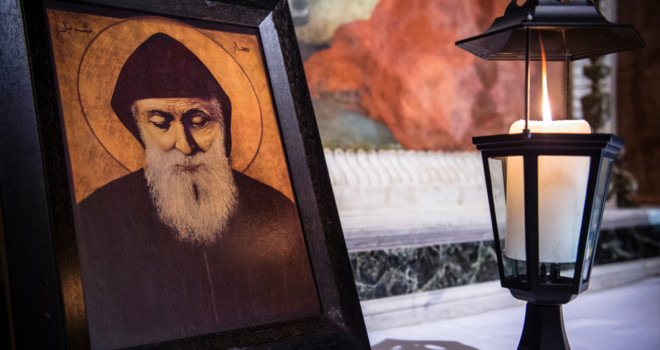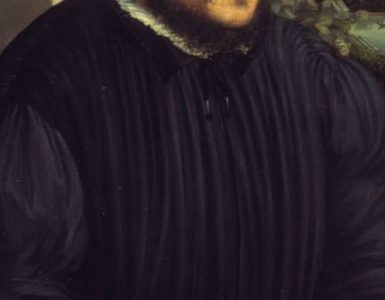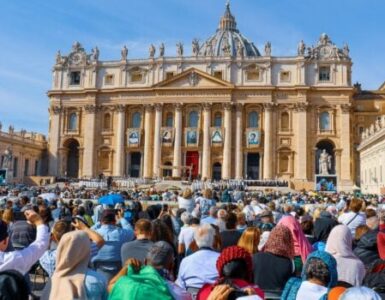It’s a common practice for devout Catholics to lean into a devotion toward a specific saint, perhaps unofficially adopting him or her as a patron, maybe relying on his or her intercession for specific situations (think of St. Anthony of Padua, called upon for lost items). St. Charbel Makhlouf, a Lebanese saint who bridged Eastern and Western Catholic monasticism by living the Maronite Rule, is one such exemplar.
His heart longed for unity among Christians and Muslims, and he was gifted at doing so through his meek disposition and his life centered deeply around prayer. This fact may be the key to why so many people of all walks of life and religious beliefs have turned to his intercession with astounding results.
St. Charbel is a saint for
our times. The aesthetic of his monastic life has a universal appeal, one that
perhaps draws us away from our anxious and busy lives and into the realm of
silence, solitude, and deeper prayer. He, like every saint whether well known
or unknown, wants us to come through him to know and love God with more
confidence and greater peace.
Who Is St. Charbel Makhlouf?
Born Youssef Antoun
Makhlouf in 1828 as one of five children, he lived in the highest mountain of
Lebanon, Bekaa Kafra. His father died when he was only three years old, leaving
his mother a widow with young children. Providentially, she remarried a very
devout man who went on to become an ordained parish priest in the village where
the family lived. Youssef also had two uncles who were hermits, and as a boy he
would take the family’s small flock of sheep to a nearby Marian grotto and
spend most of his day in prayer.
He left his family in 1851 to enter the Maronite monastic order, where he studied theology and philosophy. Twenty-four years later, he was granted permission to live the solitary life of a hermit and did so faithfully for the remaining thirty-three years of his life. Notably, the monks who knew him recognized his natural ability to follow the Rule with perfect peace and obedience. He died on Christmas Eve, 1898.
His Mystical Life of Suffering
St. Charbel’s name means
“God’s good news” in Aramaic. He was certainly a clandestine harbinger of such
holiness. Immediately after his novitiate began, he donned the habit that
included a black robe, symbolizing death to himself; a black-tasseled belt,
which reminded him of the scourge of Jesus. Every time it is touched, the monk
prays, “With your pain, O Jesus Christ.”
St. Charbel wanted to be
given the most onerous and humiliating work while at the monastery, which was
granted to him. Yet, as he harvested crops, the monks in his community observed
the level of sacred care with which he did so. It was said that the degree of
his poverty, chastity, and obedience and the humility with which he exemplified
his vows is “unsurpassed.”
The day after he died,
Christmas Day, a small group of monks at the hermitage noticed a brilliant glow
emanating from his coffin shortly before interment. The light shone continually
for four months until permission was granted to open his casket. Once this was
done, the light revealed a perfectly incorrupt body of the saintly man, and the
cause for his canonization began shortly thereafter. It was determined by
medical professionals that there was no scientific explanation for the glow or
his incorrupt body.
His life and death were explained to be “more angelic than human.”
Monasticim, Both Ancient and New
St. Charbel was a Maronite
monk who lived as a hermit in Lebanon during the late nineteenth century.
St. Paul VI said of St. Charbel as he closed the Second Vatican Council on December 5, 1965, “Great is the gladness in heaven and earth today for the beatification of Charbel Makhlouf, monk and hermit of the Lebanese Maronite Order. Great is the joy of the East and West for this son of Lebanon, admirable flower of sanctity blooming on the stem of the ancient monastic traditions of the East, and venerated today by the Church of Rome…. The holy monk of Annaya is presented as one who reminds us of the indispensable role of prayer, hidden virtues and penance…”
Thousands of recorded
miracles have been attributed to St. Charbel’s intercession throughout the
years, especially by pilgrims who travel to North Lebanon in gratitude for
unexplained physical healings in particular. People with diseases of the eye,
spinal malformations, and other physical ailments have received dramatic
reversals of their conditions and instantaneous, total healings.
Why We Need St. Charbel’s Intercession
Suffering exists in many
forms, and St. Charbel knew this well. He lived it excellently. He chose to
spend his entire life in mortification of his senses, which led him to
spiritual simplicity and total abandonment to God’s holy will for his life. He
wants us to learn this, too. In our frenzied culture, we tend to lose sight of
God as we fill the painful chasms of our hearts with distractions, diversions,
and all sorts of clutter.
St. Charbel invites us to
a sort of monastic renewal, regardless of our vocational state, so that we can,
as St. Alphonsus Liguori once wrote, “retreat often into the cell of our
hearts.” We can begin to trust God, regardless of our suffering and
uncertainties, so that like St. Charbel, we may be totally resigned to His love
until the end of our days on earth.
Here is a novena prayer to St. Charbel to get you started if you have an urgent need or feel drawn to receive his intercession.
✠
image: AM113 / Shutterstock.com










